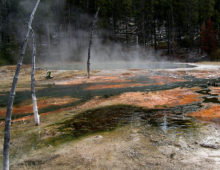Heat stress impairs plant growth and reduces crop yield. In nature, temperature and day length are linked together; longer days tend to have higher temperatures than shorter days. Little is known about how photosynthetic organisms regulate and integrate their responses to high temperature and day length to optimize growth. The team will use green alga…
Metabolic Diversity of Sorghum and Maize
Leveraging genetic and biochemical approaches with JGI contributions, researchers aim to better understand the metabolic diversity of sorghum and maize, how that metabolic diversity is generated, and how specific metabolites and pathways mediate plant interactions with the microbial community. Together these resources and knowledge are anticipated to guide development of next generation Poaceous fuel crops…
Molecular Mechanisms of Parasitic Chytrids
Chytrids hinder algal biofuel cultivation by causing population crashes, but little is understood about how and under what conditions chytrids infect algae. Recently, researchers have found that the chytrid Paraphysoderma sedebokerense is a facultative algal parasite of Haematococcus pluvialis, whose trophic strategy is regulated by dissolved organic carbon availability. The molecular changes underlying its switch…
Bacteria and Fungi in Native Prairies
Despite the persistent presence of potentially harmful fungi and bacteria, America’s native prairies are healthy, thriving communities of perennial herbaceous plants. How do these communities maintain a balance with these microbes? Bacteria and fungi found in native prairie soil, are mutually antagonist and thus may keep each other in check. Each produces antibiotic compounds when…
Dynamics of Wetland Mangrove Ecosystems
Wetland mangroves are among the most productive ecosystems on the planet, generating a substantial amount of methane each year. Researchers know very little about how the microbial communities responsible for methanogenesis respond to climatic shifts. Since these communities experience strong subtropical seasonal and diurnal changes in light and temperature, the team aims to track temporal…
Elucidating Viral “Dark Matter”
This proposal seeks to study viruses and microbes in nearly unexplored extreme environments including hydrothermal vents, glacial sea ice, and modern and ancient sea brines. The team will develop catalogs of which viruses are there, and use these to explore their genomes to identify genes the viruses have ‘stolen’ to augment a key microbial metabolism…
Microbial Success in Legume-Rhizobia Mutualism
Recent advances have revealed the importance of microbes on plant and animal health. For plant productivity, no microbe-plant association is more important than that between rhizobia bacteria and legume plants. This symbiosis is the major natural contributor of nitrogen, a nutrient that limits plant growth in agricultural and natural systems. This work will identify genes…
Quantifying Cyanobacteria Interactions
Photosynthetic microbes play a major role in the Earth’s complex biogeochemical cycles. The vast populations of photoautotrophic cyanobacteria in the oceans, terrestrial and freshwater environments fix significant amounts of carbon and nitrogen. These phototrophic hosts are prey to viruses that release carbon and other nutrients, so the long term objective is to quantify dynamic interactions…
Iron- and Sulfur-Oxidizing Sediment Bacteria
Iron and sulfur are important elements to all life on Earth. Some groups of bacteria use iron and sulfur as energy sources and make organic carbon (sugars) from carbon dioxide in the atmosphere. These bacteria, known as iron- and sulfur-oxidizing bacteria, are found in the sediments and waters of the ocean and on land. They…
Dynamic Behavior of Soil Ecosystems
By incubating soil with position-specific 13C-labeled glucose and determining the isotope distribution in the pyruvate that is produced, researchers will distinguish between two forms of glycolysis that may occur in intact microbial communities. Additionally, they will sequence DNA and RNA from soils and use that information to improve metabolic models. Improved understanding of microbial energy…
